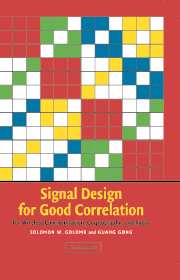Book contents
- Frontmatter
- Contents
- Preface
- Acknowledgments
- Historical Introduction
- 1 General Properties of Correlation
- 2 Applications of Correlation to the Communication of Information
- 3 Finite Fields
- 4 Feedback Shift Register Sequences
- 5 Randomness Measurements and m-Sequences
- 6 Transforms of Sequences and Functions
- 7 Cyclic Difference Sets and Binary Sequences with Two-Level Autocorrelation
- 8 Cyclic Hadamard Sequences, Part 1
- 9 Cyclic Hadamard Sequences, Part 2
- 10 Signal Sets with Low Crosscorrelation
- 11 Correlation of Boolean Functions
- 12 Applications to Radar, Sonar, Synchronization, and CDMA
- Bibliography
- Index
3 - Finite Fields
Published online by Cambridge University Press: 15 August 2009
- Frontmatter
- Contents
- Preface
- Acknowledgments
- Historical Introduction
- 1 General Properties of Correlation
- 2 Applications of Correlation to the Communication of Information
- 3 Finite Fields
- 4 Feedback Shift Register Sequences
- 5 Randomness Measurements and m-Sequences
- 6 Transforms of Sequences and Functions
- 7 Cyclic Difference Sets and Binary Sequences with Two-Level Autocorrelation
- 8 Cyclic Hadamard Sequences, Part 1
- 9 Cyclic Hadamard Sequences, Part 2
- 10 Signal Sets with Low Crosscorrelation
- 11 Correlation of Boolean Functions
- 12 Applications to Radar, Sonar, Synchronization, and CDMA
- Bibliography
- Index
Summary
Finite fields are used in most of the known constructions of pseudorandom sequences and analysis of periods, correlations, and linear spans of linear feedback shift register (LFSR) sequences and nonlinear generated sequences. They are also important in many cryptographic primitive algorithms, such as the Diffie-Hellman key exchange, the Digital Signature Standard (DSS), the El Gamal public-key encryption, elliptic curve public-key cryptography, and LFSR (or Torus) based public-key cryptography. Finite fields and shift register sequences are also used in algebraic error-correcting codes, in code-division multiple-access (CDMA) communications, and in many other applications beyond the scope of this book. This chapter gives a description of these fields and some properties that are frequently used in sequence design and cryptography. Section 3.1 introduces definitions of algebraic structures of groups, rings and fields, and polynomials. Section 3.2 shows the construction of the finite field GF(pn). Section 3.3 presents the basic theory of finite fields. Section 3.4 discusses minimal polynomials. Section 3.5 introduces subfields, trace functions, bases, and computation of the minimal polynomials over intermediate subfields. Computation of a power of a trace function is shown in Section 3.6. And, the last section presents some counting numbers related to finite fields.
Algebraic structures
In this section, we give the definitions of the algebraic structures of groups, rings and fields, polynomials, and some concepts that will be needed for the study of finite fields in the later sections.
- Type
- Chapter
- Information
- Signal Design for Good CorrelationFor Wireless Communication, Cryptography, and Radar, pp. 22 - 80Publisher: Cambridge University PressPrint publication year: 2005



